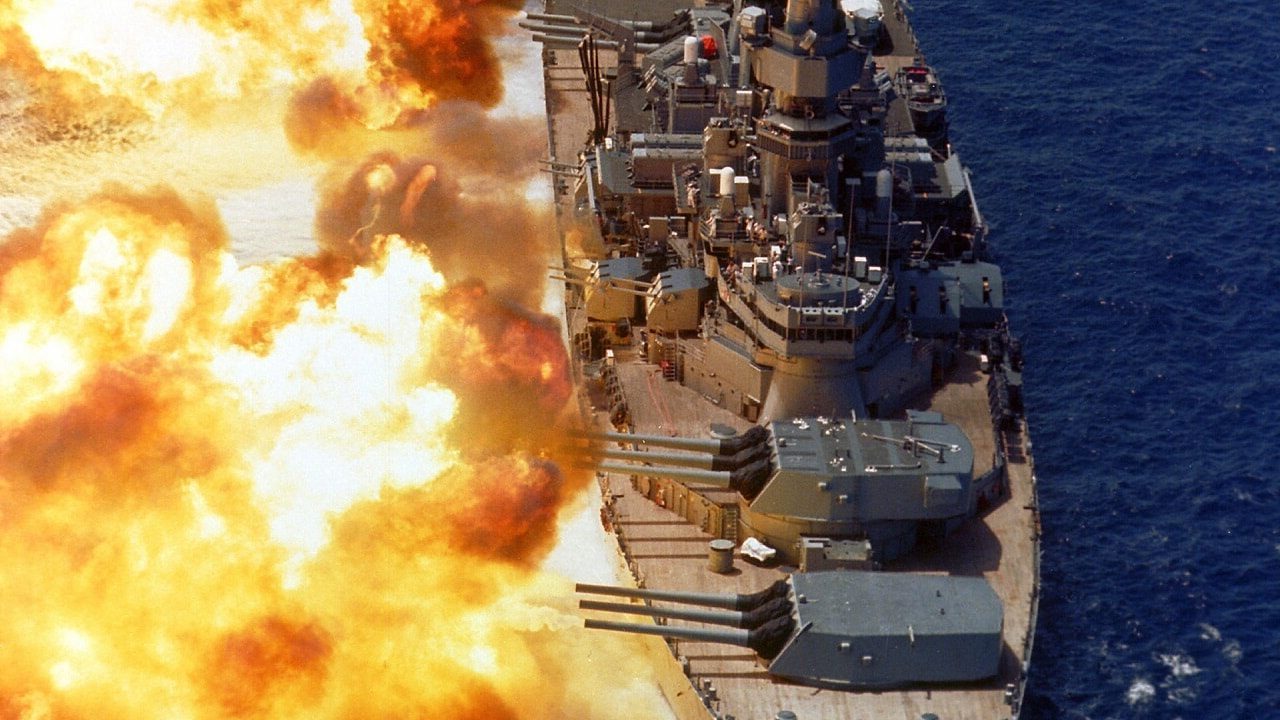The U.S. Navy’s very last class of battleships, the Iowa-class, was indeed historic, with many experts claiming they could be brought back out of retirement. But what was the reason these warships were so dangerous? Easy answer: those big 16-inch guns:
During the Second World War, the Imperial Japanese Navy (IJN) launched two of the largest and most powerful battleships ever to set sail.
Both Yamato and her sister vessel Musashi were equipped with nine 45.7cm (18-inch) guns.
Each of those massive naval cannons had a range of some 27 miles (43.5 km). Yet both ships were sunk by American aircraft and the only time the IJN vessels fired those guns in anger was during the Battle of Leyte Gulf, yet, they failed to hit any enemy targets.
The United States Navy’s final battleships – the Iowa-class – were armed with smaller, yet, still highly capable main guns that saw use during the Second World War and well beyond. The last of those guns were fired in anger during the 1991 Gulf War in Iraq.
Meet the 16-inch/50-caliber Mark 7 Gun
Seeing the clouds of war on the horizon, following Japan’s failure to ratify the London Naval Treaty of 1935, the U.S. Navy proceeded to develop a new class of warship. Displacement was increased to 45,000 tons, with designers using the added tonnage for extra power as well as protection instead of more powerful armament.
Navy officials took the opinion that it had reached an acceptable plateau when it came to the main armament of battleships, and although the guns were not actually increased in terms of size or number, they were improved in quality with the development of the new 50-caliber 16-inch (406mm) Mark 7 guns, which replaced the 45-caliber weapons that were used on the South Dakota-class.
The new Iowa-class of “fast battleships” mixed speed and firepower and this enabled it to travel with a carrier force. Capable of reaching speeds of up to 33 knots, they were fast-moving, while heavily armed with nine of its 16-inch guns as well as ten twin five-inch guns. Like all battleships, the Iowa-class carried heavy armor protection against shellfire and bombs, as well as underwater protection against torpedoes. Protection of the new battle wagons was on the same scale as the preceding class but was carefully designed along more conventional lines. In addition, the Iowa-class used a new turret that saved almost 850 tons (864 tonnes) in total.
Bigger Guns?
The nomenclature of the Mark 7 can be a little confusing, however, as it basically meant that the guns were 50 calibers long – or 50 times their 16-inch bore diameter, which made the barrels 66.7 feet (20.3 meters) long, from chamber to muzzle. Each gun weighed about 239,000 pounds (108,000 kg) without the breech – and 267,900 pounds (121,500 kg) with the breech. More importantly, the Mark 7 gun was able to fire projectiles weighing from 1,900 to 2,700 pounds (860 to 1,220 kg) at a maximum speed of 2,690 feet per second (820 m/s). The range was up to 24 miles (39 km) and at maximum range, the projectile could spend almost a minute and a half in flight.
Another common misnomer about the Iowa-class is that it had triple gun turrets, but this is not technically correct. In fact, the turrets were actually “three-gun” and not “triple” as each barrel could be elevated and fired independently. Moreover, each gun could be elevated from -5 degrees to +45 degrees, moving at up to 12 degrees per second. The turrets could also rotate about 300 degrees at about 4 degrees per second.
The Iowa-class battleships could fire any combination of guns, including a broadside of all nine. However, there is a misconception that such broadsides would require the ship to move sideways – yet, it is really an illusion. The mass of the warship and the dampening effect of the water around the hull would have kept the ship stable and stationary.
The Mark 7 gun fired two basic rounds, a 2,700 pound AP (Armor Piercing), which could penetrate up to 30 feet of concrete; and a 1,900 pound HC (High Capacity) shore bombardment projectile.
Final Service
During the service of the Iowa-class, the 16-inch guns had been used countless times – with the guns first being fired in anger off the Truk Atoll in February 1944, when USS Iowa (BB-61) and USS New Jersey (BB-62) engaged the IJN destroyer Nowaki at a range of 35,700 yards (32.6 km). The action set the record for the longest-range straddle in history.
During that engagement, which was part of Operation Hailstone, the U.S. battle wagons went on to successfully sink the IJN light cruiser Katori, the destroyer Maikaze, and the auxiliary cruiser Akagi Maru. It was actually the only surface exchange that the Iowa-class battleships were known to have engaged in.
The guns were primarily used to strike land targets, and the Mark 7 was employed during numerous landings in the Pacific War. The weapons were used again during the Korean War, and later in the Vietnam War and the Lebanese Civil War. The Mark 7 gun was employed for the final time in anger during Operation Desert Storm when more than 1,000 rounds were fired in support of ground operations.
Peter Suciu is a Michigan-based writer who has contributed to more than four dozen magazines, newspapers and websites. He is the author of several books on military headgear including A Gallery of Military Headdress, which is available on Amazon.com. Suciu is also a contributing writer for Forbes Magazine.
From 19FortyFive
A Russian Submarine Accidently ‘Destroyed Itself’
Total Massacre’: Ukraine Footage Shows Russian Cruise Missile Shipment Attacked

